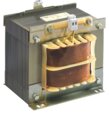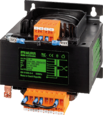Single Phase Transformers
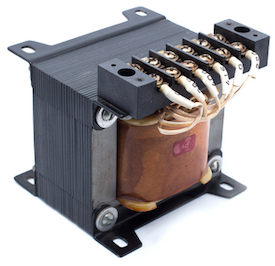
Figure 1: Single-phase transformer
A transformer is a passive component that transfers electric energy from one circuit to another or more circuits. Single-phase transformers can either step up (increase) or step down (decrease) AC voltage. Transformers have a wide range of uses and can be classified based on their uses. This article discusses the definition, construction, advantages, disadvantages, and applications of single-phase transformers.
Table of contents
- Types of transformers based on the electric network
- Single-phase vs three-phase transformers
- Faraday's law of electromagnetic induction
- What is a single-phase transformer?
- Working
- Construction
- Applications
- Advantages
- Disadvantages
- FAQs
View our online selection of transformers!
Types of transformers based on the electric network
According to the electric network used, transformers are either classified as;
- Single-phase transformers
- Three-phase transformers
A single-phase transformer (Figure 2 labeled A) works on a single-phase power supply and contains a single winding on the primary and secondary sides. A 3-phase transformer works on a three-phase power supply, and both primary and secondary windings have three sets of windings. Read our three-phase transformers overview article for more details about the construction and wiring diagrams of a three-phase transformer.
In most cases, single-phase transformers take up less space than other transformers. It is also easy to transport single-phase transformers compared to three-phase transformers. However, using one three-phase transformer is more efficient than three single-phase transformers.
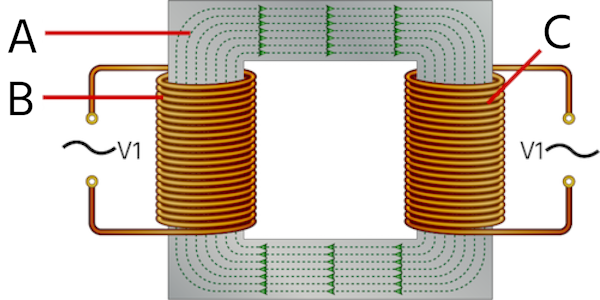
Figure 2: Single-phase with primary (A) and secondary windings (B) and the magnetic core (C).
Single-phase vs three-phase transformers
- The power supply in a single-phase transformer is through one conductor, while in three-phase transformers, the power supply is through three conductors.
- A single-phase transformer requires two wires to complete the circuit, while a three-phase transformer requires four wires to complete the circuit.
- If a single-phase transformer carries 230V, a three-phase transformer carries 415V.
- A single-phase transformer uses a simple network, while a three-phase transformer uses a complicated network.
- A power failure occurs in single-phase transformers, while there is no power failure in three-phase transformers. Vibrations are significantly reduced in three-phase motors since power distributes uniformly throughout the cycle.
- Single-phase transformers are used for home appliances, while three-phase transformers run a heavy load.
Faraday's law of electromagnetic induction
Faraday's Law of electromagnetism predicts how a magnetic field will interact with a circuit to produce an electromotive force. Faraday's Law consists of:
- Faraday's first law of electromagnetic induction states that whenever a conductor is in a varying magnetic field, there is electromotive force (EMF).
- Faraday's second law of electromagnetic induction states that the induced electromotive force equals the rate of change of flux linkages.
What is a single-phase transformer?
A single-phase transformer operates on single-phase power and has two parts - the magnetic and the electric parts. The magnetic transformer part consists of a magnetic iron core, while the electric part consists of a copper transformer. Read our electrical transformers overview article for more details on the construction of a transformer.
Only alternating current operates the transformer because direct current does not create an electromagnetic field. A transformer doesn’t have any moving parts; hence, there is no mechanical friction when operating a single-phase transformer. Therefore, there are few energy losses when using a single-phase transformer, making the single-phase transformer highly efficient.
When a transformer's primary winding encounters an alternating current, it generates an alternating electromagnetic field. A part of the generated magnetic field links with the secondary winding through mutual induction, producing a current. Voltage is induced in the secondary windings with the same frequency as primary windings. Faraday's Law can determine the value of the induced voltage.
Working
A single-phase transformer works based on the principle of mutual inductance. The primary windings connect to an alternating current supplying power to the coil, which builds up a magnetic field. The process of magnetic field build-up is known as mutual inductance, and the current flows through the coil as per Faraday's Law.
The magnetic field created strengthens when the current flowing through the coil increases, building magnetic lines of force. The magnetic lines of force form the magnetic flux, and the secondary winding links the system to the magnetic flux.
The turns ratio between the primary and secondary windings will determine the strength of the generated magnetic field. An increase in current leads to an increase in the magnetic flux - they are directly proportional. The flowing magnetic flux in the core induces a voltage in the secondary winding. The value of the induced voltage can be determined using Faraday's Law.
Construction
The single-phase transformer has a primary and a secondary winding. The windings are placed on a magnetic core constructed from silicon steel laminations. The purpose of the magnetic core is to provide a path for the magnetic flux. Silicon steel reduces hysteresis losses, while the laminations reduce losses due to eddy-current (localized electric current induced in a conductor due to the varying magnetic field.
The laminations are thin sheets put together to form the core. Enamel insulating coating insulates the laminations from each other. Based on construction, single-phase transformers can be core-type or shell-type.
Core-type transformer
The transformer has two vertical legs (limbs) and two horizontal sections (yokes) in the magnetic current. Half of the primary and secondary windings are placed on each limb to minimize the effect of leakage flux. The two windings form a cylindrical winding (Figure 3 labeled A)
Shell-type transformer
The transformer has three limbs in a magnetic circuit. The windings are in the middle limb, and the other limbs complete the low reluctance flux path (Figure 3 labeled B). The primary and secondary windings have two sub-divisions; the low voltage and the high voltage section.
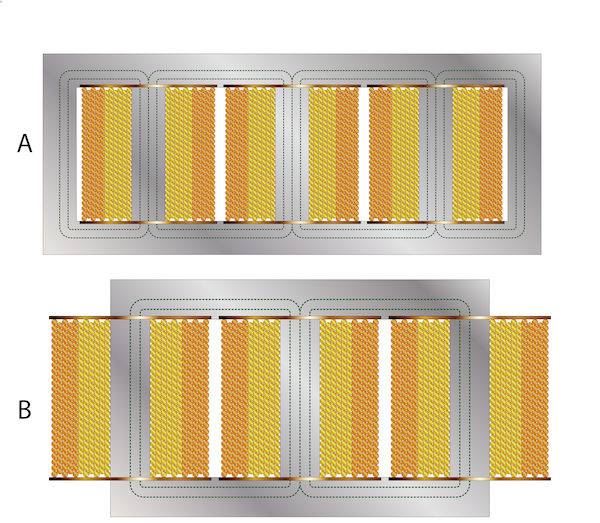
Figure 3: Core-type (A) and shell-type (B) transformers
Applications
The single-phase transformer is mainly used in low voltage appliances like home devices. Some of the applications of a single-phase transformer are:
- Decrease voltage in localized power distribution
- Regulation of voltage in television sets
- Used in lighting and heating devices
- Used in areas where the demand for electricity is low, such as rural areas
- Increasing voltage in home inverters
Advantages
- The system is reliable, and service continuity ensures when transformers are connected in parallel.
- Transformers work in parallel, reducing the possibility of overloading.
- The transformer can switch on or off based on the load demand.
Disadvantages
- It is costly to maintain.
- It requires a lot of installation space.
- There is a chance of failure when transformers are connected in parallel.
FAQs
How many types of transformers are there?
Three primary types – capacitor, electromagnetic, and optical
What does a single-phase transformer mean?
A single-phase transformer is a type of transformer operating on single-phase power. A single-phase transformer has two parts - the magnetic transformer and the electric parts.
What type of power supply do homes use?
Homes use a single-phase power supply.
How are single-phase transformers wired?
Single-phase transformers can either be connected into series or parallel arrangements.
On which principle does the single-phase transformer operate?
Single-phase transformers operate under the principle of Faraday's Law of electromagnetic induction. Faraday's Law is a law of electromagnetism that predicts how a magnetic field will interact with a magnetic circuit to produce an electromotive force.





